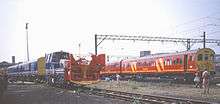Rail Express Systems
Rail Express Systems was a sector of British Rail. Upon the sectorisation of British Rail during the 1980s, the Parcels Sector was created. In 1991, this was re-branded as Rail Express Systems.
This sector of British Rail was responsible for transport of mail and parcels traffic, including the Travelling Post Office trains, as well as taking over the charter operations from Intercity.
History
The Rail Express Systems launch event was held at Crewe Diesel Depot in October 1991. For this event, examples of Class 08, 47, 86 and 90 locomotives were painted into a new livery of red, with a grey upper band, and light blue and grey flashes. The light blue and grey flashes represent a set of stylised eagle's wings.
The sector had maintenance depots at Crewe Diesel, Bristol Barton Hill, Cambridge and Euston Downside. Rolling stock was also maintained by other sectors at Heaton depot in Newcastle and Liverpool Edge Hill.
During the existence of the Parcels sector there were many changes in the use of rail to deliver mail and parcels. Smaller services were cut back, and mail services were removed from most passenger stations. These changes were in part through the Railnet scheme initiated in 1996 which created mail hubs at Shieldmuir (Motherwell), Low Fell (Gateshead), Warrington, Doncaster, Bristol Parkway, Tonbridge, and Wembley PRDC (London) as well as dedicated platforms at Stafford.
The company was bought by English Welsh & Scottish in 1996.
Mid 1990s routes
|
|
Parcels Sector rolling stock
The late 1980s and early 1990s saw many changes to the Rail Express Systems fleet, with the cessation of the usage of Class 105s by 1987, Class 114s by 1990, Class 120s by 1987, Class 127s by 1989, Class 302s by 1996 and Class 308s by 1989.
In the same period, Class 325 EMUs were introduced and the entire parcels and mails fleet (except the Travelling Post Office stock) was refurbished or withdrawn.
| Class | Image | Number | Power | Notes |
|---|---|---|---|---|
| Class 08 | Diesel Shunter | |||
| Class 31 | Diesel Locomotive | |||
| Class 47 | Diesel Locomotive | |||
| Class 86 | AC Electric Locomotive | |||
| Class 90 | 5 | AC Electric Locomotive | ||
| Class 105 | Diesel Multiple Unit (DMU) | |||
| Class 114 | .jpg) | 10 | DMU | |
| Class 120 | DMU | |||
| Class 127 | 23 | DMU | ||
| Class 302 |  | 6 | Electric Multiple Unit (EMU) | |
| Class 308 | 3 | EMU | ||
| Class 325 | .jpg) | 16 | EMU |
| Coach Type | Image | Number | Notes |
|---|---|---|---|
| NAA - Propelling Control Vehicle | 24 | ||
| NBA - Brake Gangwayed (High-security) | |||
| NDX - Brake Gangwayed (90 mph) | |||
| NEX - Brake Gangwayed (100 mph) | |||
| NHA - Brake Gangwayed (110 mph) | |||
| NIA - Brake Gangwayed (High-security) (110 mph) | |||
| NJX - General Utility Van (90 mph) | |||
| NKA - General Utility Van (High-security) (100 mph) | |||
| NLX - Newspaper Van | |||
| NNX - Courier Vehicle | |||
| NPX - General Utility Van (TPO use) | |||
| NOA - General Utility Van (100 mph) | |||
| NRA - Container Van | |||
| NSA - Post Office Sorting Van | 10+ | ||
| NTA - Post Office Stowage Van | |||
| NUA - Brake Post Office Stowage Van |
References
- Rail Magazine Issue 159
- Motive Power Pocket books pub. Platform 5
- British Multiple Units Volume 1 and Volume 3